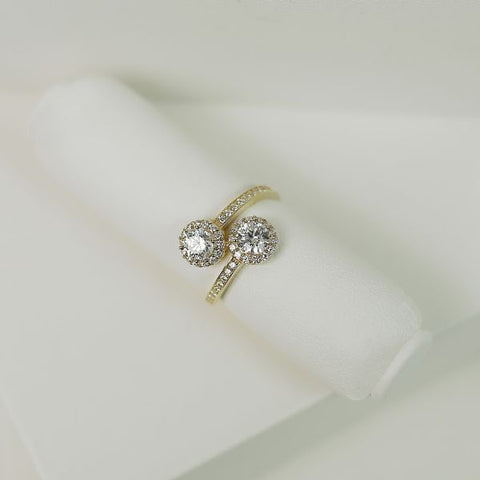
Choose a Ring Setting: The Ultimate Guide to Engagement Ring Settings
Congratulations! You've decided to take the exciting step of choosing an engagement ring. It's an incredibly special moment that marks the beginning of a beautiful journey. But amidst all the joy and anticipation, there's a crucial decision that awaits you: the selection of the perfect ring setting.
Whether you're a soon-to-be-engaged individual shopping for your significant other or a supportive friend or family member lending a helping hand, this guide is here to assist you every step of the way.
Here's a sneak peek into what you'll discover:
-
The anatomy of an engagement ring
-
What is an engagement ring setting?
-
What are high-set vs. low-set engagement rings?
-
Types of Engagement Ring Settings
-
Factors to consider when choosing any one of these settings.
-
The Difference between setting and style?
The anatomy of an engagement ring
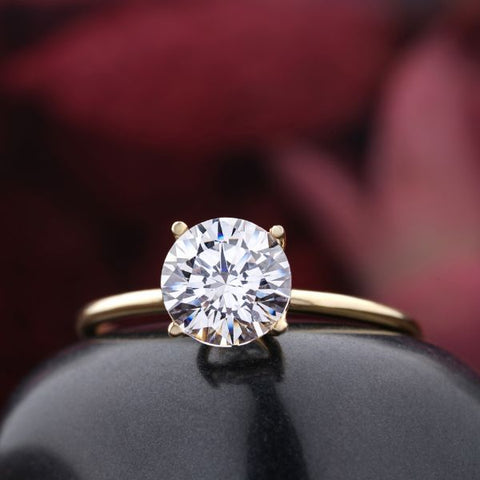
An engagement ring consists of several key components, each serving a specific purpose and contributing to the overall design and functionality of the ring. The main parts of an engagement ring include:
Center Stone: The central focal point of the ring, usually a diamond or another gemstone. The center stone is typically the largest and most prominent feature of the ring.
Setting: The mechanism or structure that holds the center stone in place on the band. Common types of settings include prong, bezel, channel, pavé, and halo settings.
Band: The circular portion of the ring that encircles the finger. Bands can vary in width, thickness, and design, and are typically made of precious metals such as gold, platinum, or silver.
Prongs: Thin metal claws or prongs that extend from the setting to secure the center stone in place. Prongs can vary in number and configuration depending on the setting style.
Accent Stones: Additional gemstones that may be set into the band or around the center stone to enhance its beauty and sparkle. Accent stones can be diamonds or other colored gemstones.
Gallery: The area beneath the center stone and setting, sometimes referred to as the "basket" or "head" of the ring. The gallery provides support for the center stone and allows light to enter from underneath, enhancing its brilliance.
Shoulders: The upper portion of the band on either side of the center stone. Shoulders can be plain or adorned with accent stones or decorative details.
Shank: The lower portion of the band that wraps around the finger. The shank can be plain or embellished with textures, engravings, or additional stones.
Understanding the anatomy of an engagement ring can help you appreciate its design and craftsmanship and make informed decisions when selecting or designing the perfect ring.
What is an engagement ring setting?
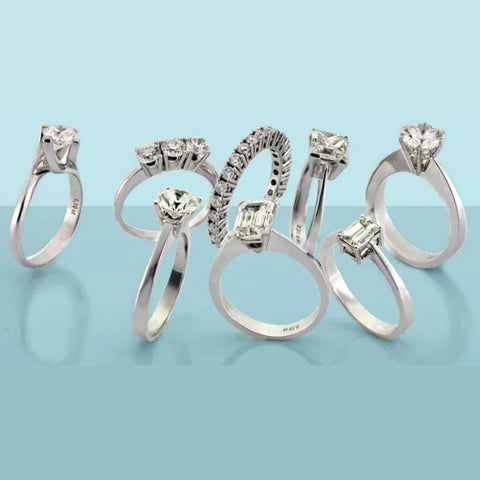
An engagement ring setting refers to the way in which the center stone or stones of the ring are placed and secured onto the band. The setting not only holds the stone in place but also adds to the overall aesthetic appeal of the ring. Before you Buy Diamond Engagement Ring, know more about various types of engagement ring settings, each with its unique features and characteristics.
What are high-set vs. low-set engagement rings?
High-set engagement rings and low-set engagement rings refer to the height at which the center stone sits on the band. Let's define both settings:
High-Set Engagement Ring:
High-set engagement ring: In this setting, the center stone is elevated above the band, creating a prominent and noticeable profile.
A high-set engagement ring is characterized by the placement of the center stone being elevated above the band. This setting allows the gemstone to be prominently displayed and catch more light, enhancing its sparkle and brilliance. Here are three pros of a high-set engagement ring:
Enhanced Visibility: The elevated position of the center stone allows it to catch more light from different angles, enhancing its brilliance and making it more noticeable.
Elongates the Finger: High-set rings often create an illusion of elongated fingers, which can be flattering for individuals with shorter fingers.
Opportunity for Intricate Designs: With more space available underneath the center stone, high-set rings offer opportunities for intricate and detailed designs, such as elaborate metalwork or additional accent stones.
Low-Set Engagement Ring:
Low-set engagement ring: In this setting, the center stone sits closer to the band, resulting in a more subtle and understated appearance.
Conversely, a low-set engagement ring is characterized by the center stone being set closer to the band, typically in a more subtle and understated manner. Here are three pros of a low-set engagement ring:
Practicality and Comfort: One of the advantages of a low-set engagement ring is its practicality and comfort. The closer proximity of the center stone to the band reduces the overall height of the ring, making it less likely to catch on clothing or get in the way during everyday activities. This can be particularly appealing to individuals with active lifestyles or those who prefer a more understated and practical ring design.
Subtle Elegance: A low-set engagement ring offers a more subtle and understated elegance compared to its high-set counterpart. The closer placement of the center stone to the band creates a sleek and streamlined look, perfect for those who prefer a minimalist aesthetic. This style of ring can exude sophistication and class without being overly flashy or ostentatious.
Versatility in Pairing: Due to its lower profile, a low-set engagement ring tends to be more versatile when it comes to pairing with wedding bands or other jewelry. The streamlined design allows for easier stacking with additional rings, providing more options for customization and personalization. Whether it's a simple wedding band or a more intricate design, a low-set engagement ring can complement a variety of styles and preferences.
TYPES OF ENGAGEMENT RING SETTINGS
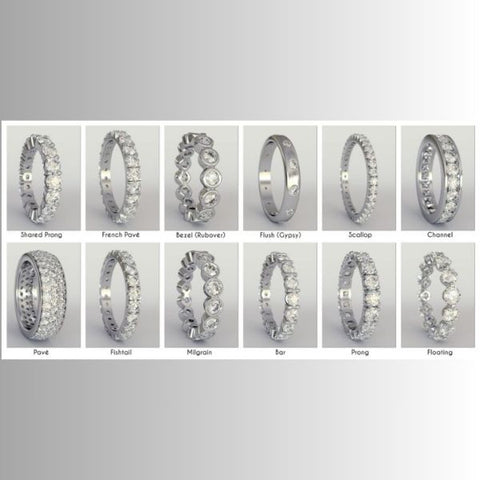
Here's a breakdown of the pros and cons of different types of ring settings that can help you make a valid decision to Buy Diamond Engagement Ring:
Prong Setting:
Pros:
-
Showcases the Diamond: Prong settings use minimal metal, allowing more light to enter the diamond, enhancing its brilliance and sparkle.
- Versatile: Prong settings can accommodate various diamond shapes and sizes, making them a versatile choice.
-
Easy Maintenance: Cleaning and maintaining prong settings is relatively straightforward compared to other settings.
- Classic Look: Prong settings offer a timeless and elegant appearance, suitable for traditional engagement rings.
Cons:
-
Prone to Damage: The exposed nature of prongs makes them susceptible to bending or breaking, especially if they're not well-made or maintained.
-
Potential for Snagging: The raised prongs can catch on clothing or other objects, posing a risk of damage or injury.
- Need for Regular Inspection: Due to the risk of prongs loosening over time, prong-set rings require periodic inspections and maintenance.
Bezel Setting:
Pros:
-
Security: Bezel settings encase the diamond with a metal rim, providing excellent protection against damage and loss.
-
Modern Appearance: Bezel settings offer a contemporary and sleek look, appealing to those seeking a more modern aesthetic.
-
Low Maintenance: With no prongs to worry about, bezel-set rings typically require less maintenance and are less likely to snag on clothing.
- Enhanced Color Perception: The metal surrounding the diamond can enhance its perceived color, making it appear whiter or more vibrant.
Cons:
-
Less Light Exposure: The metal rim of a bezel setting can obstruct some light from entering the diamond, potentially reducing its brilliance.
-
Limited Stone Visibility: Some individuals may prefer settings that showcase more of the diamond, which is partially covered in a bezel setting.
- Slightly Bulkier Look: Bezel settings may add a bit of extra bulk to the overall appearance of the ring compared to more minimalist settings like prongs.
Pave Setting:
Pros:
-
Added Sparkle: Pave settings feature small diamonds set closely together, creating a shimmering effect that enhances the brilliance of the center stone.
-
Elegant Appearance: Pave settings exude luxury and sophistication, making them a popular choice for those seeking a glamorous look.
-
Versatility: Pave settings can be used to accentuate the band or frame the center stone, allowing for various design possibilities.
- Cover Imperfections: Pave settings can conceal minor flaws or inclusions in the band by diverting attention to sparkling diamonds.
Cons:
- Potential for Diamond Loss: The numerous small diamonds in a pave setting may pose a higher risk of falling out if the setting is not well-made or maintained.
- Complex Cleaning: Cleaning pave-set rings requires extra care to avoid dislodging the small diamonds or trapping dirt between them.
- Higher Cost: Pave settings typically involve more labor and materials, resulting in a higher overall cost compared to simpler settings like prongs or bezels.
Channel Setting:
Pros:
-
Secure Stones: The channel setting securely holds stones in place with metal channels on either side, reducing the risk of stones becoming loose or falling out.
-
Smooth Surface: This setting offers a sleek and smooth surface, making it less likely to snag on clothing or other materials.
- Enhanced Brilliance: Stones set in a channel setting are often closely spaced, allowing for more light to reflect off the stones, enhancing their brilliance.
Cons:
-
Limited Stone Shapes: Channel settings are typically designed for round or straight-edged stones, limiting the variety of shapes that can be used.
-
Difficult to Clean: Dirt and debris can accumulate in the channels over time, making it challenging to clean without professional assistance.
- Less Individuality: Because stones are set flush against each other, there's less room for customization or unique arrangements.
Bar Setting:
Pros:
-
Secure Setting: The bar setting holds stones securely in place with metal bars on either side, reducing the risk of stones becoming loose or falling out.
-
Visible Stones: Stones in a bar setting are exposed on all sides, allowing more light to enter and enhancing their sparkle and brilliance.
- Versatile Design: Bar settings can accommodate various stone shapes and sizes, offering more flexibility in design options.
Cons:
-
Prone to Damage: The exposed nature of the stones in a bar setting makes them more susceptible to damage from knocks and bumps.
-
Difficult to Clean: Dirt and debris can accumulate around the bars, making it challenging to clean thoroughly.
- Potential for Snagging: The raised bars can sometimes catch on clothing or other materials, leading to potential snagging.
Tension Setting:
Pros:
-
Modern Aesthetic: Tension settings offer a contemporary and minimalist look, with the stone appearing to float between the metal band.
-
Maximum Light Exposure: The tension setting allows for maximum light exposure to the stone, enhancing its brilliance and sparkle.
- Unique Design: Tension settings are distinctive and eye-catching, making them a popular choice for those seeking a non-traditional engagement ring.
Cons:
-
Specialized Maintenance: Tension settings require precise maintenance to ensure the stone remains securely held in place, which may necessitate periodic adjustments by a professional jeweler.
-
Limited Stone Options: Tension settings are typically designed for harder stones like diamonds or sapphires, limiting the variety of gemstones that can be used.
- Less Secure: While tension settings are designed to securely hold the stone in place, there's still a risk of the stone becoming loose or dislodged if the setting is damaged or compromised.
Illusion Setting:
Pros:
-
Enhanced Appearance: The illusion setting uses smaller stones or metal to create the illusion of a larger center stone, providing a more impressive appearance without the added cost.
-
Customization: This setting allows for creativity in design, with various arrangements and combinations of smaller stones or metalwork to create unique looks.
- Cost-Effective: By using smaller stones or metal to create the illusion of a larger center stone, the illusion setting can be more budget-friendly compared to purchasing a single large stone.
Cons:
-
Durability Concerns: The smaller stones or metal used in the illusion setting may be more prone to damage or wear over time compared to a single larger stone.
-
Less Brilliance: The illusion setting may not provide the same level of brilliance or sparkle as a single large stone, as the smaller stones may not reflect light as effectively.
- Maintenance Challenges: Cleaning and maintaining an illusion setting can be more challenging due to the intricate design and smaller components, requiring extra care to prevent damage or loss of stones.
Cluster Setting:
Pros:
-
Dazzling Appearance: Cluster settings feature multiple smaller stones grouped together, creating a dazzling and impactful look that can rival larger single stones.
-
Versatility: Cluster settings offer versatility in design, allowing for various arrangements and combinations of stones to create unique and personalized looks.
- Cost-Effective: Using smaller stones in a cluster setting can be more cost-effective than purchasing a single large stone of equivalent carat weight.
Cons:
-
Maintenance Challenges: Cleaning and maintaining a cluster setting can be more challenging due to the multiple stones and intricate design, requiring extra care to prevent damage or loss of stones.
-
Potential for Snagging: The raised and clustered nature of the stones in this setting may increase the risk of snagging on clothing or other materials.
- Less Individuality: While cluster settings offer versatility in design, they may not provide the same level of individuality or customization as settings with a single focal stone.
Factors to consider when choosing any one of these settings.
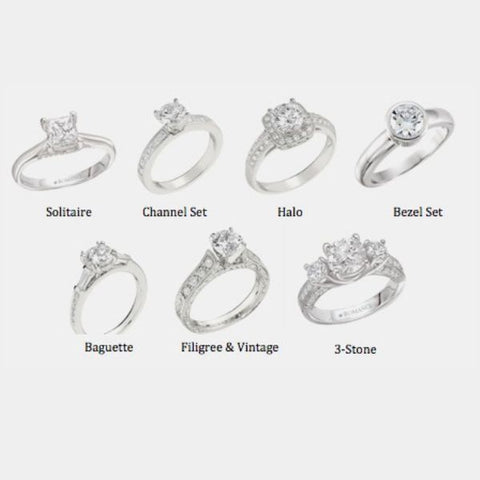
To choose the right engagement ring setting, consider the following factors:
- Consider the wearer's lifestyle and daily activities. A high-set ring may be more prone to catching on clothing or getting snagged in certain situations.
- Ensure the setting securely holds the center stone in place to prevent it from becoming loose or damaged over time.
- Keep in mind the wearer's personal style preferences. Some individuals may prefer the bold and statement-making look of a high-set ring, while others may prefer a more understated design.
- Take into account the size and shape of the center stone. A high-set setting can accentuate the brilliance and size of a larger center stone, whereas a smaller stone may appear overwhelmed by a high-set design.
- The shape of the center stone plays a significant role in determining the suitable setting. For example, a round diamond typically looks stunning in a prong setting, while a princess-cut diamond may shine in a channel or bezel setting.
- Some settings are more prone to damage or require more maintenance than others. Be sure to choose a setting that suits the recipient's lifestyle and daily activities. For instance, a bezel setting provides excellent protection for the stone, making it ideal for someone with an active lifestyle.
- Different settings may vary in cost due to factors such as complexity and materials used. Set a budget and explore options within that range.
- Consider the metal type for the band of the ring. Common choices include white gold, yellow gold, rose gold, platinum, and sterling silver. Choose a metal that complements the stone and matches the recipient's preferences.
- Think about the practicality of the setting. Some intricate designs may be more challenging to clean, while others may snag on clothing or get caught on objects.
- Ultimately, the right engagement ring setting is one that reflects the recipient's style, fits within your budget, and ensures the durability and longevity of the ring.
The difference between setting and style in the context of engagement rings lies in their respective roles and characteristics:
Setting: The setting of an engagement ring refers to how the center stone or stones are placed and secured onto the band. It includes the mechanism or structure that holds the stone in place, such as prongs, bezels, channels, or pavé settings. The setting not only provides support and security for the stone but also contributes to the overall design and appearance of the ring.
Style: The style of an engagement ring encompasses the overall aesthetic and design elements of the ring. It includes factors such as the shape and cut of the center stone, the metal type and color of the band, the presence of accent stones or embellishments, and any decorative details or motifs. Engagement ring styles can range from classic and traditional to modern and contemporary, as well as vintage-inspired or custom designs.
In summary, while the setting determines how the stone is mounted onto the band, the style encompasses the broader design choices and visual elements of the ring.
How do I choose a setting that complements my existing jewelry collection?
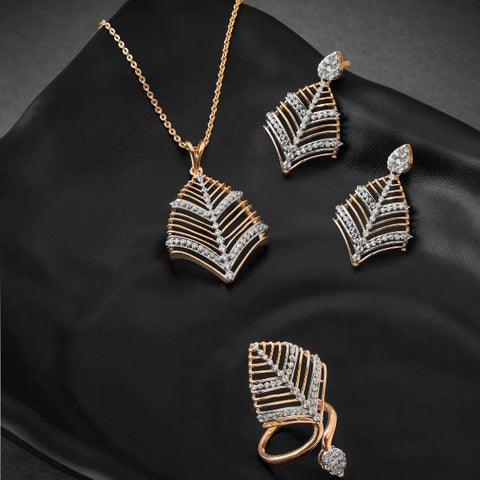
Choosing a setting that complements your existing jewelry collection can enhance the overall look and feel of your accessories. Here are five pointers to help you make the right choice when you decide to Buy Diamond Engagement Ring:
Consider Your Current Pieces: Take a close look at the jewelry you already own. Pay attention to the styles, metals, and gemstones present in your collection. This will give you a better idea of the overall aesthetic you're drawn to and help you choose a setting that harmonizes with your existing pieces.
Match Metals: Matching the metal of your new setting with the metals in your current collection is crucial for a cohesive look. For example, if you predominantly have gold jewelry, opting for a setting in yellow gold, rose gold, or even gold-plated would complement your collection well. Similarly, if your collection features silver or platinum pieces, choose a setting in those metals for consistency.
Consider Gemstone Compatibility: If your existing jewelry includes gemstones, consider how the new setting will interact with them. For instance, if you have a lot of pieces with colored gemstones like rubies or sapphires, you might want to choose a setting that allows these stones to stand out, such as a simple prong setting. Alternatively, if your collection features primarily diamonds, a setting like pavé or channel setting could be a good fit.
Think about Style and Design: Take into account the overall style and design of your existing jewelry. If you have a collection of vintage-inspired pieces, you might want to choose a setting that complements that aesthetic, such as filigree or milgrain detailing. On the other hand, if your collection leans towards modern and minimalist designs, a sleek and simple setting like a bezel or tension setting would be more suitable.
Consider Versatility: Opt for a setting that offers versatility and can be paired with multiple pieces in your collection. For example, a classic solitaire setting for a ring or a simple pendant setting for a necklace can easily complement a variety of styles and occasions, making them versatile additions to your jewelry wardrobe.
By considering these pointers and evaluating your existing collection, you can choose Buy Diamond Engagement Ring which not only complements your current pieces but also enhances the overall cohesiveness and appeal of your jewelry collection.
FAQ’s
Are there settings that are better for protecting the gemstone from damage?
Yes, there is a setting that's particularly good for protecting gemstones from damage, and it's called the bezel setting. In a bezel setting, the gemstone is completely surrounded by a metal rim that holds it securely in place. This setting offers excellent protection because the metal rim acts as a barrier, preventing the gemstone from coming into direct contact with hard surfaces that could potentially cause scratches or chips. Additionally, the bezel setting covers the edges of the gemstone, further reducing the risk of damage from accidental impacts. Overall, choosing a bezel setting can help keep your gemstone safe and looking beautiful for years to come.
How does the size and shape of the diamond influence the choice of setting?
The size and shape of a diamond play a significant role in choosing the right setting. Larger stones may require more substantial settings to securely hold them in place. Similarly, different diamond shapes complement certain settings better; for instance, a round diamond typically fits well in a prong setting, while a marquise or pear-shaped diamond might be better suited for a bezel or halo setting.
How does my lifestyle impact the choice of ring setting?
Your lifestyle influences the choice of ring setting as it determines the level of wear and tear the ring will endure. For active individuals or those working with their hands frequently, a low-profile setting like a bezel or flush setting may be preferable to minimize the risk of catching or damaging the stone. On the other hand, individuals with a less active lifestyle might opt for more intricate settings without worrying about potential damage.
What is the cost difference between different ring settings?
The cost of ring settings varies depending on factors such as the type of metal used, the complexity of the design, and any additional embellishments like diamonds or gemstones. Generally, simpler settings like solitaire or plain bands are more affordable compared to intricate settings with pavé or channel-set diamonds. Additionally, the choice of metal—such as platinum, gold, or silver—affects the overall cost of the setting.
How can I ensure the ring setting is secure and durable?
To ensure the ring setting is secure and durable, several factors should be considered. First, opt for reputable jewelers to Buy Diamond Engagement Ring who use high-quality materials and craftsmanship. Ensure that the prongs or bezels holding the stone are well-made and properly aligned to prevent the stone from becoming loose or falling out. Regular maintenance, such as professional cleaning and inspections, also helps identify and address any potential issues before they escalate.
Make Your Engagement Ring Purchase Special!!
Looking for the perfect diamond engagement ring to symbolize your special bond? Look no further than Shemesh Diamonds, your go-to destination for the best online diamond rings. At Shemesh Diamonds, you'll discover a stunning array of designs crafted with exquisite diamonds, each ring a testament to the unique connection between you and your partner. Whether you're drawn to classic elegance or modern flair, Shemesh Diamonds offers something for every style and preference. Explore our collection today and embark on the journey to finding the ring that will capture your love and commitment in the most beautiful way possible.

